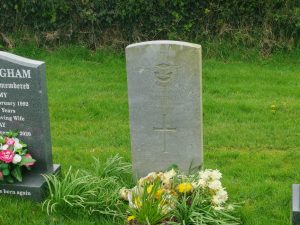Robinson, T (Thomas)

Robinson, T (Thomas)
Serjeant Thomas Robinson was the son of John Robinson and Ellen Robinson; husband of Martha Robinson, of 12, Orchard Street, Londonderry, (who he married during the 1st of April 1895) and father of George, Fred and Mary Ellen. He was born at Killeen, Castlederg.
Thomas originally served in the 1st Royal Inniskilling Fusiliers for over 19 years and was discharged on the 6th of September 1901 after originally enlisting during 1882. Thomas was at the time, medically unfit, possibly due to the wounds he received in Africa as he served in the 2nd Boer war[1] and received clasps for Cape Colony[2] and the Relief of Ladysmith.[3] He was unfortunately wounded at the Battle of Colenso.[4]
Thomas then re-joined the Royal Inniskilling Fusiliers on the 14th of September 1914, retaining his old rank of Serjeant.[5] He then moved to the 16th Battalion Worcestershire Regiment[6] and then to the Royal Irish Regiment, 1st Garrison Battalion on its formation on the 2nd of August 1915. A month later during the 6th of September 1915 he and his men disembarked for Gallipoli from Devonport, England, landing on the 24th of September 1915 at Moudros.[7]
During October 1915, the 1st Garrison Battalion of the Royal Irish Regiment sent working parties into Suvla Bay, Gallipoli and after the withdrawal they moved to Egypt, landing there on the 5th of February 1916. The regiment would remain in North Africa until the end of the war.
A few weeks after arriving, during the 13th of February 1916. Serjeant Thomas Robinson was in N.15 General Hospital, Alexandria due to illness. Just over a year later, on the 17th of March 1917 Thomas was charged with being drunk while on active service.
Within 6 months though, on the 30th of September 2017, Serjeant Robinson returned home due to illness and transferred to the 1st Battalion of the Royal Worchester Regiment and after a few years he was for the final time discharged on the 11th of March 1919 due to him being unfit for service.
Another year passed and on the 27th of March 1920, Thomas passed away from “malignant disease of the tongue and jaw”.
It is possible though that he may have died from the 1918 outbreak of the Spanish Flu pandemic.[8]
The Spanish flu is rather deceiving as it did not originate in that country of its namesake. Spain though was the first country to openly report on the pandemic due to its neutrality in the war. Therefore, the illness received its name by this association.
The outbreak began around January 1918 and ended at the end of 1920. There were three major outbreaks, each deadlier than the previous. Great efforts were made to suppress the news, but so many people were affected that it became pointless as the flu crept through the armies and into the villages, towns, and cities of Europe. There were no vaccines to protect against this flu virus or the infections, no antiviral drugs to treat it and no antibiotics to treat secondary bacterial infections like pneumonia. The only tools that authorities could implement was the promotion of good personal hygiene, isolation, and quarantine of the ill, along with the closures of public places.
There are several servicemen in the City Cemetery who possibly died of the illness, most of whom were diagnosed with meningitis, flu, or pneumonia. It especially affected young adults.
Serjeant Thomas Robinson was laid to rest on the 29th of March 1920.
He was awarded the 1914/15 Star, the British War and Victory Medals and Queen’s South Africa Medal with Cape Colony and Relief of Ladysmith clasps.
Serjeant Robinson registered no next of kin when he signed up, but his wife (Martha Robinson) made a claim for his medals on his behalf. When she received the 1914/15 star, the wrong rank was on it, and she returned it to be corrected.
Date of Death: 27/03/1920 (Aged 57)
Service: Serjeant, The Royal Irish Regiment, 1st Garrison Battalion, Royal Inniskilling fusiliers, 1st Battalion and the Worcestershire Regiment, 9th Battalion.
Service Number: 111, 47152, 12095 and 4136
Burial Location: Londonderry (or Derry), City Cemetery, S. B. 608.

[1] The Second Boer War in South African, started on 11th October 1899 and ended on 31st May 1902.
[2] Cape Colony Clasp was awarded for service in the Cape of Good Hope where no clasp for a specific action in the Cape had been received between the dates of 11th of October 1899 and the 31st of May 1902.
[3] Relief of Ladysmith Clasp was awarded to the garrison of Ladysmith, Natal, during the siege between the dates of the 3rd of November 1899 and the 28th of February 1900.
[4] Battle of Colenso took place on the 15th of December 1899, the British were defeated with the British losses being 143 killed, 756 wounded, and 220 captured while the Boer casualties were only 8 killed and 30 wounded.
[5] Service Number: 12095
[6] Service Number: 4136
[7] Moudros is a town on the island of Lemnos, North Aegean, Greece. During the Dardanelles Campaign of the First World War, the town and its harbour were used as an Allied base.
[8] Spanish Flu: 50 to 100,000,000 deaths.







